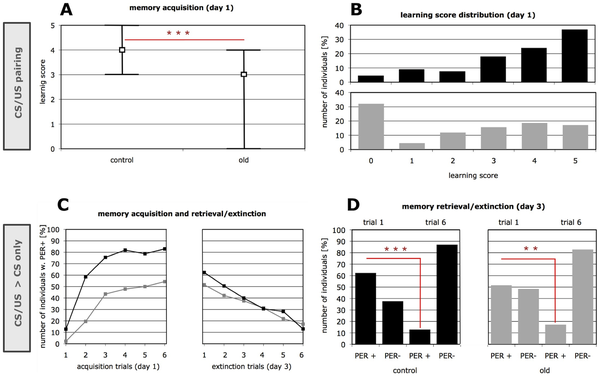Bees are typically impressive navigators, able to wend their way home through complex landscapes after visits to flowers far removed from their nests, even after three to four days of flight time. Mature bees have piloted their way to and from the hive for five to 11 days and old bees have had more than two weeks of flight time but the paper says that aging impairs the bees' ability to extinguish the memory of an unsuitable nest site even after the colony has settled in a new home.
To test how old bees adapt to a changed home location, researchers trained bees to a new nest box while their former nest was closed off. Groups composed of mature and old bees were given several days in which to learn the new home location and to extinguish the bees' memory of their unusable former nest box.
The scientists then disassembled the bees' new home and forced groups of mixed-age bees to choose between three alternative nest locations, including the former nest box. Old bees with symptoms of senescence preferentially oriented toward the former nest site, despite the experience that should have told them that it was unusable.

Acquisition, memory retention and extinction in old forager bees as compared to mature controls. The foraging durations in the two test groups were either less than 10 days (control) or longer than 15 days (old). (A) The learning performance in the old group was significantly reduced, as compared to the mature controls. Higher LS (up to LS = 5) indicate good learning performance, while lower LS indicate positive responses to the conditioned stimulus (CS, carnation oil) only in few or none (LS = 0) of the CS-US pairings. The graph shows medians and interquartile ranges with n = 133/134 for control and old, respectively. (B) Reduced learning performance in the old group is contrasted by increased performance heterogeneity (F = 1.65, p = 0.002, df1 = 132, df2 = 133, F-test; compare also interquartile ranges in A). Histograms of individual learning scores with n = 133/134 for control and old, respectively). (C) Acquisition, memory retention and extinction. To test acquisition a subset of bees was subjected to 6 CS-US pairings on day 1 (left). On day 3 bees were presented 6 times with the CS alone for testing memory retention (1st trial) and extinction (response decay in the 6th as compared to 1st trial). The y-axis displays the percentage of individuals that responded to the CS by extending the proboscis (PER+). Day 1 with n = 94/92, day 3 with n = 85/64 for control and old, respectively. Differences in individual numbers between day 1 and 3 are mainly caused by mortality, specifically affecting the group of old foragers. (D) No significant difference in memory retention was detected when comparing the response of the two age groups to the first CS only presentation (n = 85/64 for control and old, respectively). After six extinction trials, PER- individuals do not respond to the learned CS-US association, and thereby show extinction. While response decline after extinction trials was less significant in the old group, a direct comparison of both groups does not reveal a significant age affect for extinction of olfactory memory (for details see results section). Asterisks in A, B, D denote significance (A, Chi-square; B, Mann-Whitney U; D, McNemar χ2).
"From previous studies, we knew that old bees are characterized by poor learning when trained to floral odors in the laboratory," says Gro Amdam, an associate professor in the School of Life Sciences at Arizona State University. "So, we wanted to test whether aging also affects learning behavior that is important for a bee's survival in the wild."
The scientists believe that their findings with bees offer a new means to model and understand the variability found in brain function between individuals; where some individuals' memories remain intact, while others' learning behavior becomes inflexible with age.
Citation: Münch D, Baker N, Kreibich CD, Bråten AT, Amdam GV, 'In the Laboratory and during Free-Flight: Old Honey Bees Reveal Learning and Extinction Deficits that Mirror Mammalian Functional Decline', PLoS ONE 5(10): e13504. doi:10.1371/journal.pone.0013504




Comments